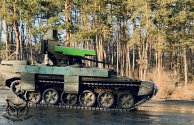Another "Russian propaganda" turned out to be true. Ukrainian mobilization is carried out with violations of the law.
Military recruiters are accused of rough tactics as they try to boost the headcount:
Ruslan Kubay was surprised to receive a draft notice in late January. Registered as seriously disabled since childhood—Mr Kubay is missing both hands—he falls under a list of automatic exemptions from service. Even more surprising, however, was the reaction of officials at the local registration office in Drohobych, near Lviv. Far from admitting their error, they doubled down and declared him fit for service. Only a social-media post and subsequent national scandal reversed the decision. “I was disgusted by how easily our blind people can start seeing,” he wrote on Facebook.
Mr Kubay’s case was an extreme, but far from isolated, incident. Ukraine has visibly stepped up mobilisation activities in the first two months of this year. For unclear reasons, officials in western Ukraine have been the most aggressive, but the trend is clear across the country. There have been reports of draft notices issued (and sometimes violently enforced) at military funerals in Lviv, checkpoints in Kharkiv, shopping centres in Kyiv and on street corners in Odessa. Popular ski resorts lie deserted despite the first proper snows of the winter—footage of military officials snooping around at the slopes was enough to keep the crowds away. In every town and city across the country social-media channels share information about where recruitment officers might be lurking.
Mobilisation has been going on since the beginning of the war. Unlike in Russia, the process is not hidden: in February, President Volodymyr Zelensky extended martial law and general-mobilisation legislation for the sixth time. But there have been big changes since December. Previously only members of Ukraine’s draft commission were allowed to issue notices, and only at home addresses. Now a wider group of officials can issue the two-part document, and there is no geographical limitation. Another difference is who is being called up. In the first wave most of the recruits were voluntary; queues outside draft offices were a frequent sight. Now officials are recruiting from a much less enthusiastic crowd.
In December Ukraine’s top soldier, Valery Zaluzhny, told
The Economist there was no immediate need for massive mobilisation; his main problems were armour and munitions. Sources within the general staff insist that is still the case. Moreover, there are natural limits to the numbers of soldiers Ukraine can absorb, says Viktor Kevlyuk, a reserve colonel. “You can’t mobilise 6,000 if your training ranges can only hold 3,000,” he says.
But force ratios, which once favoured Ukraine, have since tilted back towards Russia, which has mobilised at least 250,000 men since September. Meanwhile, Ukraine’s military leadership has been charged with building a reserve in advance of an expected counter-offensive. New Western hardware is arriving, and it needs to be manned. And heavy attrition rates in close-contact fighting on the eastern front, around the embattled town of Bakhmut, need to be balanced with new men.
There has always been a disconnect between Ukrainian law and practice. That gap has grown larger in wartime, as the military bureaucracy struggles to keep pace with increased demands. The drafting process has become particularly suspect in recent weeks, says Andrii Novak, a lawyer representing several draftees. “A draft notice has to be addressed to a particular person, and that person has to be on a list,” he says. Unhelpfully, Ukrainian legislation offers no clear guidance for how notices should be issued under martial law. What is clear, Mr Novak says, is that recruits cannot be asked to simply fill out forms in the street—let alone do so under duress, as some have.
In a country like Ukraine, there are inevitably less-than-legal ways to escape the call-up too. “It’s a dialectic of nature,” says Colonel Kevlyuk, who worked in the General Staff until 2021. “Wherever there is demand, you’ll always find someone to supply it.” Some arrange fictitious marriages with mothers of three or more children. Others get corrupt military doctors to issue a medical exemption. For a few thousand dollars, one can pay to be smuggled across the border. But the appetite for risk is falling after a series of well-publicised draft-dodging prosecutions.
Government officials say excesses are being addressed as they come to light. But with the army set on achieving a military breakthrough before the summer, recruitment of less-motivated Ukrainians will surely be stepped up, and scandals will probably continue. The armed forces may respond to legal challenges by improving its bureaucracy, but there are other ways to deal with them too. Informed sources say that at least two lawyers disputing draft orders have abruptly been called up themselves. As the army well knows, mobilised lawyers are automatically barred from practising.


